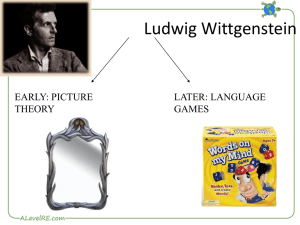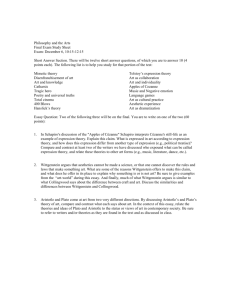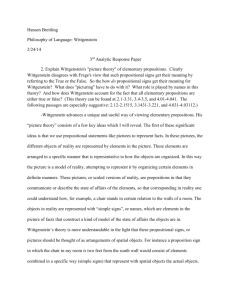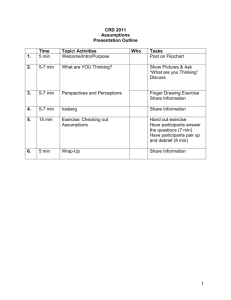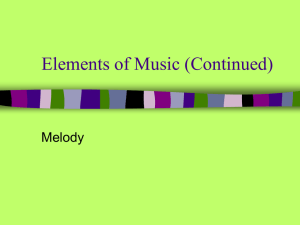Reason Motive and Cause from a Wittgensteinian Perspective
advertisement
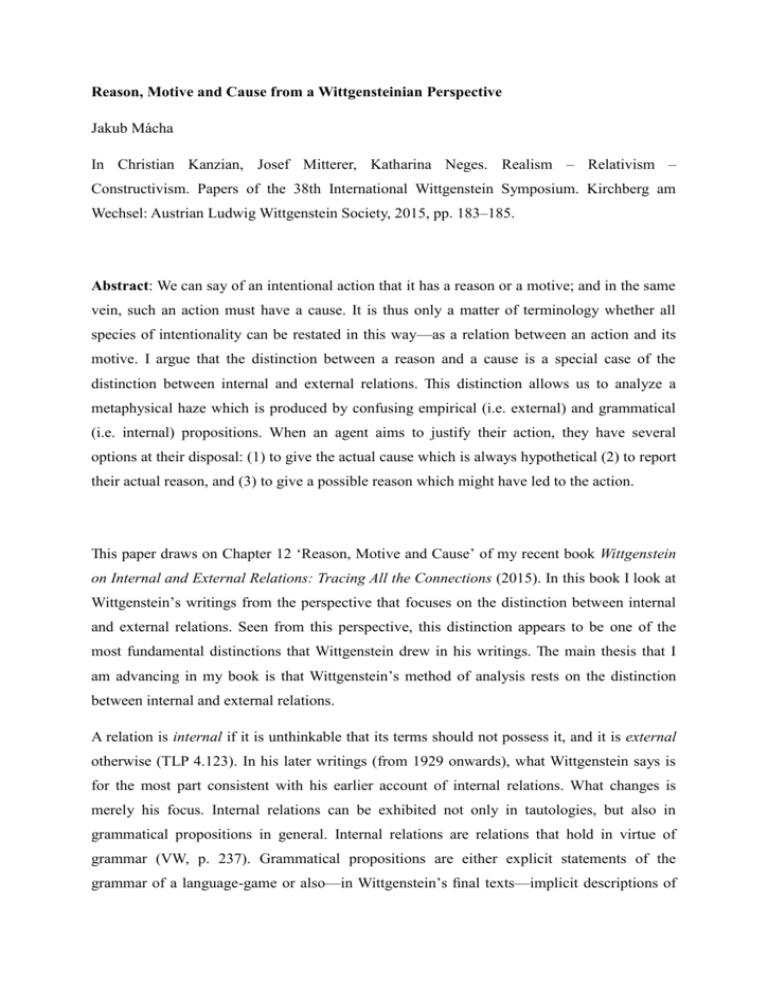
Reason, Motive and Cause from a Wittgensteinian Perspective Jakub Mácha In Christian Kanzian, Josef Mitterer, Katharina Neges. Realism – Relativism – Constructivism. Papers of the 38th International Wittgenstein Symposium. Kirchberg am Wechsel: Austrian Ludwig Wittgenstein Society, 2015, pp. 183–185. Abstract: We can say of an intentional action that it has a reason or a motive; and in the same vein, such an action must have a cause. It is thus only a matter of terminology whether all species of intentionality can be restated in this way—as a relation between an action and its motive. I argue that the distinction between a reason and a cause is a special case of the distinction between internal and external relations. This distinction allows us to analyze a metaphysical haze which is produced by confusing empirical (i.e. external) and grammatical (i.e. internal) propositions. When an agent aims to justify their action, they have several options at their disposal: (1) to give the actual cause which is always hypothetical (2) to report their actual reason, and (3) to give a possible reason which might have led to the action. This paper draws on Chapter 12 ‘Reason, Motive and Cause’ of my recent book Wittgenstein on Internal and External Relations: Tracing All the Connections (2015). In this book I look at Wittgenstein’s writings from the perspective that focuses on the distinction between internal and external relations. Seen from this perspective, this distinction appears to be one of the most fundamental distinctions that Wittgenstein drew in his writings. The main thesis that I am advancing in my book is that Wittgenstein’s method of analysis rests on the distinction between internal and external relations. A relation is internal if it is unthinkable that its terms should not possess it, and it is external otherwise (TLP 4.123). In his later writings (from 1929 onwards), what Wittgenstein says is for the most part consistent with his earlier account of internal relations. What changes is merely his focus. Internal relations can be exhibited not only in tautologies, but also in grammatical propositions in general. Internal relations are relations that hold in virtue of grammar (VW, p. 237). Grammatical propositions are either explicit statements of the grammar of a language-game or also—in Wittgenstein’s final texts—implicit descriptions of our human form of life. Wittgenstein now insists resolutely that internal relations hold only between concepts and any talk of internal relations between objects has to be understood as referring to the internal relations between the concepts describing these objects (LFM, p. 73). With these definitions in mind let us now examine one concrete application of the distinction between internal and external relations in Wittgenstein writings. We can say of an intentional action that it has a reason or a motive; and in the same vein, such an action must have a cause. Let us assume that I am about to perform an action p in order to achieve q; that is to say, q was my reason for doing p. Therefore, I am about to do p because of q; thus here, q was my motive for doing p. So, for instance, an order to do p can be a reason for doing p; or my fear of q is a motive for taking action in order to avoid q, etc. Independently of this, one may ask whether q was the cause of p—or in fact what sort of causality is operating in this example. It is thus only a matter of terminology whether all species of intentionality can be restated in this way—as a relation between an action and its motive.1 To be on safer ground, one could say that the relation of being a reason for doing or a motive for doing belongs to the family of intentional relations which Wittgenstein aims to conceive as internal relations. As he stresses, the words ‘reason’, ‘motive’ or ‘cause’ can be used in very many different ways.2 The same is valid for the related expressions ‘because’ or ‘why’, etc. The diagnosis is, then, that the surface grammar of our everyday language confuses us about (or at least does not fully distinguish between) internal and external relations. In what follows I shall argue that the distinction between reasons and causes is an instance of the distinction between internal and external relations. To begin with, let us consider the following examples from Wittgenstein’s Lectures and Conversations on Aesthetics: ‘Cause’ is used in very many different ways, e.g. (1) “What is the cause of unemployment?” “What is the cause of this expression?” [Experiment and statistics] (2) “What was the cause of your jumping?” “That noise.” [Reason] As Anscombe (1957) does. LA, pp. 13 & 22; Ms 112, p. 112v; BBB, p. 15; VW, pp. 108–111. I think that Wittgenstein uses the expressions ‘reason’ [Grund] and ‘motive’ [Motiv] interchangeably (Cf. BBB, p. 15). 1 2 (3) “What was the cause of that wheel going round?” You trace a mechanism.3 In order to avoid a misunderstanding Wittgenstein wants to reserve the expression ‘cause’ for a (relation of) mechanical causality between two events. A cause in this sense can be found statistically or by tracing the underlying mechanism. This is to say that what is the cause of a certain action is always a hypothesis based on past experience. Such experience may include the knowledge of certain physical processes in one’s brain which are typically not known to an agent. An important consequence is that one cannot be absolutely sure what exactly the cause of one’s action was. It should therefore be clear that causal relations are external: they are realized between events, not concepts; they are expressed in temporal propositions. The most striking difference between a cause and a reason/motive for Wittgenstein is that an agent knows without any doubt the motive of their action: ‘we can only conjecture the cause but we know the motive.’ (BBB, p.15) Wittgenstein takes this statement to be a grammatical one. The motive for an action or the reason for a belief is something constitutive of the very action or belief: The causes of our belief in a proposition are indeed irrelevant to the question [of] what we believe. Not so the grounds, which are grammatically related to the proposition, and tell us what proposition it is. (Z §437) Now, I want to address two interrelated points: The first one concerns what counts as a motive, or as a reason. A rational motive or a reason cannot be just anything that an agent avows. The second point is the objection that a motive can be unconscious, i.e., unknown to an agent. One may later forget the original motive for one’s action or be self-deceived or insincere about it. Both these points threaten my claim that the relation of being a motive or a reason is internal. Now to the first point: a motive for an action or a reason for a belief is not arbitrary. If the relation between an action and its motive is not obvious, the agent has then to indicate a rule that has led them—step by step (cf. Ms 115, p.136)—from the motive to the action. The motive can itself be an expression of this rule. In the 1930s, Wittgenstein pondered the idea that this rule must be a kind a calculation: ‘Giving a reason is like giving a calculation by which you have arrived at a certain result.’ (BBB, p.15) This statement means that between an 3 LA, p. 13. The bracketed postscripts are by James Taylor. action and its motive there is the same kind of relation as between a mathematical equation and its result. This relation is internal. A slightly different account of this relation is to be found in the second part of the Philosophical Investigations, and in subsequent writings (PI II, p.224). The relation between an action and its motive is established here in the language-game of the judging of motives. All that is needed is a technique for the judging of a motive. A judgment within this languagegame may resemble a calculation, but it does not need to. We can think of some simple instances of judgments and take these as sorts of measuring rods in order to judge cases that are more complicated (RPP I, §633). This later account of the relation of being a motive is, thus, the generalization of the calculation-model from the 1930s. As to the second point: an agent might avow a different motive for their action than the real one (it may be a case of ignorance or self-deception or a lie). As argued above, knowledge of a cause is always hypothetical—as opposed to a motive/reason. But it seems now that a motive can also be hypothetical in the sense that it is determined by the agent’s sincere avowal. There is a certain confusion lurking here, for ‘motive’ or ‘reason’ can be ambiguous here. A reason may mean the actual reason or may mean any possible, hypothetical reason: sometimes what we say acts as a justification, not as a report of what was done, e.g. I remember the answer to a question; when asked why I give this answer, I gave a process leading to it, though I didn’t go through this process. (LA, p.22) We have to distinguish between a report of an actual or past motive and a justification of the action. The point of a report is that it should be sincere. When someone is asked for their actual motive, they should report their motive truthfully and the answer depends on their sincerity (and on their memory). But something different goes on when the agent is asked for a justification. Then it does not matter what the past motive was. All they need to give is a rule of which the present action is an instance. It does not matter whether the agent had really followed this rule.4 Wittgenstein gives several examples of sentences that are ambiguous between expressing internal or external relations. The same is true of the following kind of sentences: See VW, p. 111: ‘the reason is what he specifies. He answers with a rule. He could have also given this rule if he had not gone by it’. 4 (1) p is the motive for doing q. (2) p is the reason for believing q. If these sentences are reports of an actual motive or reason, they can be restated as being explicitly temporal: (3) p was my motive for doing q. (4) p is the reason why I now believe that q. These sentences are temporal and thus express external relations. Asking for a justification is something different. In this case, (1) and (2) are timeless and could be restated as: (5) p is a possible motive for doing q. (6) p is a possible reason for believing q. These sentences are, however, timeless and thus they express internal relations. I would like to elucidate this matter further by Wittgenstein’s analogy with a route: The question ‘Why do you believe that?’ can be compared with the question ‘How do you come to be here?’. (VW, p.47) Wittgenstein says that this question allows two answers. There are, in fact, however three answers to be found in Wittgenstein’s lecture notes. (1) The first answer consists in giving the physical or psychological cause of one’s being located here. This answer will have to describe various phenomena (e.g., stimuli, reflexes, connections of pathways in one’s nervous system, etc.), the circumstances in which they occurred, and the causal laws operating here. (2) The second answer would be specifying the way I actually went here. (3) The third answer is by giving any route that I could have got here by.5 The first answer corresponds to giving the actual cause, the second one to a report of the actual reason, and the third to a justification by giving a possible reason. The first answer expresses an external relation and the last one expresses an internal relation. In the second answer, there is expressed an external relation by means of an internal one. Wittgenstein said famously that ‘It is in language that an expectation and its fulfillment make contact.’6 This relation is the special case of the relation between an intentional state and its Wittgenstein employed this analogy several times. He considered the first and the second answer at VW, p. 47 and the second and the third one at LA, p. 22. 6 PI §445 & PG, p. 140. 5 object, i.e. the ‘thing’ that is intended. I have argued that this relation is internal, although there may be some external causality at work as well. Seeing things retrospectively, we can justify our actions by giving a (physical, mechanical) cause, or by giving a reason for that action. The reason may be the actual one, i.e. the one that led to the action, or the reason may be a hypothetical one, i.e. any reason that logically justifies the action. ‘Why did you do it?’ — I was excited and I had an urge in my mind to please her which was caused by a certain chemical or hormonal level in my brain. — Because I felt that I had to make her happy. — Because of the commandment ‘Love your neighbor as yourself.’ (Mark, 12:31). The general lesson behind Wittgenstein’s method of analysis is that two forms of expression are identified that look the same in ordinary language (recall, ‘“Cause” is used in very many different ways.’). The aim of analysis is to show, however, that they are different. To do so, firstly, one has to detect an ambiguity and, secondly, there has to be a rule or a test to resolve the ambiguity. This presupposes a generic logical distinction that makes it possible to detach the separate meanings. This distinction would be the key that allows us to say that a given expression means this as opposed to that. In my approach, I examine one important distinction in Wittgenstein’s works—namely, the distinction between internal and external relations. References Anscombe, G. E. M. 1957 Intention, Oxford: Blackwell. Mácha, J. 2015 Wittgenstein on Internal and External Relations: Tracing All the Connections, London: Bloomsbury.
